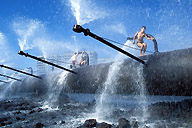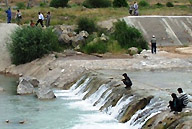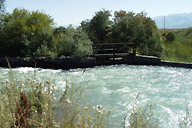 ALMATY, Kazakhstan - Forty years ago, the town of Muynak in Uzbekistan was a busy fishing port. The waters of the Aral Sea lapped up against its shoreline. Today there is no water anywhere near Muynak, and much of the Aral Sea is desert. Irrigation has been part of Central Asian society and civilization for millennia. However, when the Soviet Union doubled the area of land under irrigation, the flow of the Amu Darya and Syr Darya rivers into the Aral Sea was drastically reduced. ALMATY, Kazakhstan - Forty years ago, the town of Muynak in Uzbekistan was a busy fishing port. The waters of the Aral Sea lapped up against its shoreline. Today there is no water anywhere near Muynak, and much of the Aral Sea is desert. Irrigation has been part of Central Asian society and civilization for millennia. However, when the Soviet Union doubled the area of land under irrigation, the flow of the Amu Darya and Syr Darya rivers into the Aral Sea was drastically reduced.
While irrigated agriculture and cotton exports helped provide livelihoods for 35 million people in the Aral Sea Basin, the large-scale diversions created an ecological and human disaster for the people living near the Aral Sea. Local fishing industries disappeared as the sea retreated, and gradually saline soil and ground-water reduced agricultural productivity and led to the pollution of drinking water. Incidence of respiratory and kidney diseases increased as a result of salt dust blown by the wind and saline drinking water. The situation has further deteriorated since the break-up of the Soviet Union. Funds to maintain irrigation, drainage and water supply systems have been sharply reduced. Low incomes and unreliable water supply make it difficult to pass on these costs to consumers without better water delivery. In years past, the rivers were managed by storing water in the winter and releasing it in the summer for irrigation. Following the break-up of the Soviet Union, the upstream countries–faced with increasing prices for fossil fuel energy and growing financial constraints – began to release water to generate electricity during winter, when it cannot be used for agriculture. This led to water shortages during summer for the down-stream countries, and to large quantities of water being spilled into the desert. The World Bank has been involved in the Aral Sea basin since 1982. It supports a program designed to address the environmental and health catastrophe around the sea and provide a technical framework for cooperation among riparian countries. The Bank has also supported water and sanitation projects to improve the quality of drinking water for the people living near the Aral Sea in Uzbekistan and Turkmenistan. It is assisting in the restoration of the Northern Aral Sea and improved management of the Syr Darya in Kazakhstan. A GEF project has supported dam safety and improved the monitoring and restoration of water flow and improved energy management strategies in the area around Lake Sudochi in the Amu Darya delta.  Improved water resource management in the individual countries is key to poverty reduction and to stabilizing the level of the Aral Sea. Improved irrigation and drainage management are key because irrigation accounts for over 90 percent of water use. The Bank is supporting the rehabilitation of irrigation systems in Kazakhstan, Kyrgyzstan and Tajikistan and is now preparing projects in Uzbekistan, which accounts for half the irrigated area of the basin. Improved water resource management in the individual countries is key to poverty reduction and to stabilizing the level of the Aral Sea. Improved irrigation and drainage management are key because irrigation accounts for over 90 percent of water use. The Bank is supporting the rehabilitation of irrigation systems in Kazakhstan, Kyrgyzstan and Tajikistan and is now preparing projects in Uzbekistan, which accounts for half the irrigated area of the basin.
However, more needs to be done, especially in Uzbekistan, Tajikistan and Turkmenistan. Improved trans-boundary cooperation is most likely to be successful within an individual river basin. Technical cooperation over water-monitoring and dam safety is also a useful vehicle for cooperation, as are investments in new river regulations or electricity generation. * * * Click on the following country names to read more about active World Bank water-related projects in Kazakhstan, the Kyrgyz Republic, Tajikistan and Uzbekistan. |

